Visual perceptions constitute the majority of the human perception of the surrounding area. Therefore, they have the greatest significance in shaping the composition of forest landscapes. This is particularly important along the walking trails where the tourists have full contact with surrounding natural environment. Although there is a large subjective factor in visual perceptions of landscapes within the article is made attempt to find some objective landscape characteristics which have a decisive influence on these perceptions. Existing topography and vegetation are seen as key factors for perceptions of environmental features determining the place of observation and limits of direct visibility.
The main objective of the study is to define some principles of forest landscape design the implementation of which would improve the aesthetic qualities and the visual attractiveness of forest landscapes.
Open spaces along the walking trails provide the best opportunities for visual perceptions of tourists and analysis of forest landscapes in terms of landscape architects. There, the field of surveillance is the most spacious and gives a good choice of perspective. Since each level of monitoring we have a different horizon and a different distance to a pictorial plane. This determines as important different plans in space.
3.1. Open Spaces Metrics
Compositional and spatial aspects of visual perception of the environment are quite extensively researched in many previous studies, especially those related to prospective methods. The prospect is part of the mathematical apparatus, which depicts the area, its metrics, properties and opportunities for human exposure. The composition has a twofold role — once describes the metric of space in three dimensions and second presents the visible aspect of plan. There are many types of space. In theory perspective are essential two types of space — kinetic and visually. [4]
Kinetic is the space where we move Kinetic space is defined by orthogonal projections. One of the defining features is a geometric parallelism. It states that parallel lines never meet or intersect at one point. Visual space occurs as a result of visual perception of man. Bodies of this perception are: eye and the optical system of the human brain and eyes associated with vestibular apparatus. Visual spaces are defined by optical-based system. [1]
In the kinetic spaces metric exists equivalent various parts. It means that none of them is more important or more inaccessible by others. The directions in kinetic space are also equivalent until the moment at which the subjective perceptions of human activities resulting from this intervene. [8]
There are no limits in kinetic space composition. Viewed from above the center of the composition is independent of the limits and so it is very random. There may be many centers, according to the direction of travel. An area with minor importance could become the center and vice versa — an area that was important in some respect become secondary one. The movement into the kinetic space is an important factor in the perception of different areas as equivalent. This is due to the rapid change of one picture to another, as in a frame of film. (Figure 1) This movement of the perspective system is called locomotion, i.e. this observation is in motion. In it each of the parts of the area became the center of observation for a moment.

Figure 1. A series of views in movement throughout kinetic space
In the example in Figure 1 during the process of movement from left to right appear alternately a picturesque view with deep external linear perspective, stony meadow in foreground, mountain hill in the background and sloping mountainside. In each one of the phases of movement the respective landscape element become the center and then retreated. The images of kinetic space are the landscape fragments that we see in front of us and wherever equal importance elements alternate. (Figure 1) However not is the same with tings in visual space. In perspective views the objects standing closer to the observer get more important than objects farther from him. In this way spatial composition changed its most important feature — the balance to the center. So the spatial composition is deformed in each turn point, becoming planar and retaining only the mutual arrangement of the elements in it. For example, a group of trees located in the center of a meadow can be observed from many points on the meadow for which the center of the monitor is the group of trees on all sides. When we look through one of these points, the trees in the nearest plan would look much more than trees in the far one. The group of trees will be placed into a visual center of the meadow in which the front objects would be much larger than the distant ones. These same objects viewed from the opposite side will lose its size and importance of the composition (Figure 2).

Figure 2. Inequality of pictorial space parts in perspective views in the visual space
The front parts of space are becoming more important than distant and central parts, and more important than peripheral. The composition is limited by the field of perception, which is part of the field of vision. The center becomes important not only in two dimensions on the front panel, but has a special place in space inside. It becomes the supporting pillar of the third dimension [9]. Mutually opposing points now are not equivalent and are markers of difference from the largest object in the nearest part to the smallest back in. In this light, it is not enough a group of trees to be beautifully styled. It must be properly inserted in the space formed by many other objects to be seen in the best vision [2]. Therefore, speaking from the visual aspect, not all points in this space can be good for observation. How arrange important things in visual space? Symbol of third dimension — depth inside is the main central beam, called the direction of gaze or central axis of the prospect. [6] If you need to specify in the plan how are stacked the important sites for one point of view, their places will be on one axis, starting from the observer passing through the center of focus of sight.
3.2. Dynamic Perspective
The central entry of objects in the field of vision causes diversion of sight, changing the perspective system and tracking the object and picture in a sideways movement in the field (Figure 3). The newly formed situation develops in three ways: braking and inspection of the picture; continue to run until the picture go out of the field of vision and look back in the direction of movement; maintenance of vision direction within 30-60 ° from the direction of movement. In the third case, the change of view is caused not by compositional tune of space, but on the will of the observer, i.e. this change is not a direct result of the perspective composition. The composition however has it indirectly influence by putting an interesting object to the route of movement which causes attention to subsequent accompanying part of the space [7]. Contrast visual situation where the gaze is diverted occurs when there is contrast between the scene that is visible ahead in central direction and the pictures that appears off the route of movement.

Figure 3. Entering the interesting object in the field of vision and moving sight and field of vision to new site
For example, contrasts occur in enclosed by a wall or trees route and open space off the path, shaded part of the trails and brightly lit space away, as well as the presence of color emphasis away from the trails. When the trail changes its direction, eye tracks the areas toward the direction of travel, not interesting visual situations. This caused by the necessity interest and may be used to accommodate an interesting object just to the point where the trails change the direction. (Figure 4) The alternation of individual visual fragments along the route of movement is limited by plant groups, architectural objects or field forms in the nearest visual field term [3]. With the exception of compositions specially designed for close observation, in all other cases nearest plan does not involve sight and movement is carried forward in the central direction. When after such closing plant massif suddenly came along open light or bright space the eye automatically diverted away to look at it.

Figure 4. Entering the contrasting object in the field of vision, a change in the route and change the visual ranges
3.3. Nature of Visual Information
Most often along the walking trails manifests silhouette character of the landscape. It is translate the observation of large shapes like mountains, hills, silhouettes of forests, urban silhouettes, etc. seen from large distances (Figure 5).
In some places the character of the landscape is the kind of «scene» with a few basic plans, including: the most close-up plan with a large scale; average plan called «wings»; and longer plan called «background» [5]. In this multilayered composition the focus falls in secondary plans, enabling the vision field to include more objects than the front and rearward plans in the landscape.

Figure 5. A silhouette composition in the long run. Contrast, brightness and texture is minimized by lighting and deep distance
In this case we use medium distances, forming a wider observation ring, i.e. a range with more possible distances. Particularly important in this type of composition is the core. Very often it becomes the center precisely because it remains empty, i.e. depicts pure space. The individual plans «surround» this empty space giving it additional importance in the composition (Figure 6).
The most of the park decorative compositions are close-up landscapes with detailed forms. They require options to close distance and can very accurately determine the parameters of a perspective system to observe and pinpoint several places for static perspective system. In this type of compositions is preferably a visual design, i.e. preliminary visual drawings of the compositions, yielding a certain visual impact as it complies with certain parameters of a perspective’ system. This design can cause significant adjustments to the design plan, but in return will impact more strongly on the observer (Figure 7).
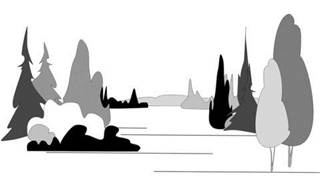
Figure 6. A multilayered composition
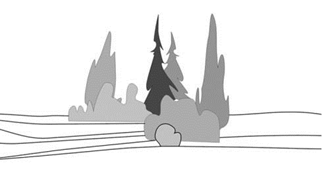
Figure 7. A close-up composition
3.4. Basic Composition Types
In this study is used a relatively simple four-graded classification. The composition forming the nearest (front) plan has small and fairly accurately measurable distances between the individual elements. It occupies space in the late first to early-term average. This is the nearest part of the core of the horizontal main plane. This type of composition is easy to focus on woody shrub groups as the center of the space. (Figure 7A)

Figure 8. Basic composition types according to the spaces they form
Composition elements of which are defined away from the observer. It retains the proportions of proximity between the elements, but overall is a greater distance inside the pictorial plane. Very often the front plans in such compositions bear a different meaning. The emptiness of these plans can be part of the visual impression. It is also possible to use different compositional forms belong on the field and in this case the perspective system must take the layout and those close details. (Figure 7B)
Composition formed from elements belonging to different plans of space. The integrity of this type of composition depends exclusively from the point of observation. Viewed from a different angle, such a combination can be seen as a number of separate compositions, and can also be observed more or less its parts. For example, if from one position of the observation the composition is composed of three main parts, then with a different look they may be 1, 2, 5, 10, etc. In the «deep» compositions, the center most often is a space surrounded by forms. In many cases this composition is a collective image of groups of other self-shaped compositions. In these cases individual compositions are formed by their own separate perspective systems and overview is made in various sizes and ratios of perspective elements. (Figure 7C)
Composition placed frontally near pictorial plane. In this composition the space is «shallow». Such compositions carry less spatial character as are important as shape and color. The details in them come to the fore and their impact is static. Nevertheless, these compositions are represented by building blocks for larger visual groups. Very often this type of composition used in the display of rhythmic compositions. That kind of closeness in space allows for viewing distant plans in basic forms like tall trees and shrubs. (Figure 7D)
It is very difficult to summarize all visual situations that predispose to stop the movement and static observation, but given previous research in the field of perspective theory and landscape architecture design we can subtract some general principles or more precisely requirements for forest landscape design along walking trails. These requirements generally relate to the design decision of volume-spatial composition of the vegetation and to a lesser extent to the formation of trails.
As the most common such a requirement may be indicated the necessity of compositional design solution and natural conditions consideration. Accordance with the most significant landscape components (relief, rock formations, lakes, rivers, streams, vegetation, etc.) always is a leading factor that ensures an adequate design solution.
Complying a rate in accent saturation is very important aesthetic rule in forest landscape design. Each recreational environment requires a correct accent dosage. This is particularly important in forest landscapes, to preserve its natural appearance and charm.
Another important condition for a positive artistic and emotional effect in forest environment is the proper proportioning of the main highlights.
Regarding the planned structure of the trails on the first place we must be careful that they should not be like axes of symmetry in the open spaces. Viewed in plan, they have to pass closer to a periphery of meadows and forest’s border and not in the middle of the open spaces.
The peripheries of forest massifs and tree groups themselves have to be designed by schemes that provide dynamic stirred outlines. Global indentation in the shape of the periphery of forest massifs provides comfortable seating «boxes» for the deployment of recreational facilities. Small finely indentation of forest edge knurling in turn gives them a natural environmental friendly appearance.
A great pursuit of every designer is in creating multilayered landscape views. These views are the biggest «prize» for tourists after many time transitions. The creation and maintenance need proper stewardship of forest vegetation which causes the eyes to focus, but also close the beautiful panoramic views.
In settling of forest landscapes as recreation environment is very important to position correctly points of accents. In the example in Figure 9 is defined properly the place in the bend of the river as a focus on composition. There are several secondary accent groups of trees and are also designed several internal linear perspectives along the promenade.
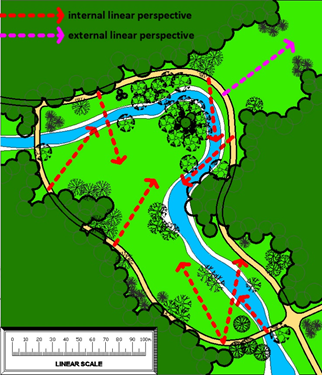
Figure 9. A landscape design project for space planning along a walking trail parallel to а stream
These favorable aesthetic effects are achieved also in the spatial design of the coastal promenade in Figure 10. There have even made deep and external linear perspectives to the opposite shores of the water area.
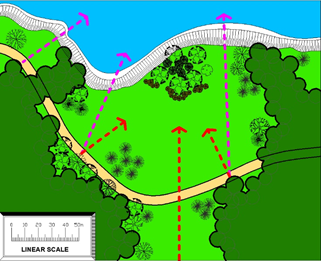
Figure 10. A landscape design project for space planning along a coastal walking trail near the shore of a water area
Among all landscape components woody vegetation to the greatest extent plays the strongest role in shaping the visual perspective views. These views are internal when the visibility is within the meadow or external when the visibility goes beyond the open space where the observer is.
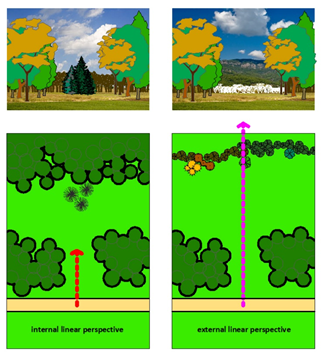
Figure 11. Internal and external linear perspectives
Figure 11 illustrates how the vegetation determines the depth of the view and serves as a barrier to short perspectives or as wings for external perspectives. Even greater is the impact of vegetation in shaping the visual frames, which exhibit perspective views.
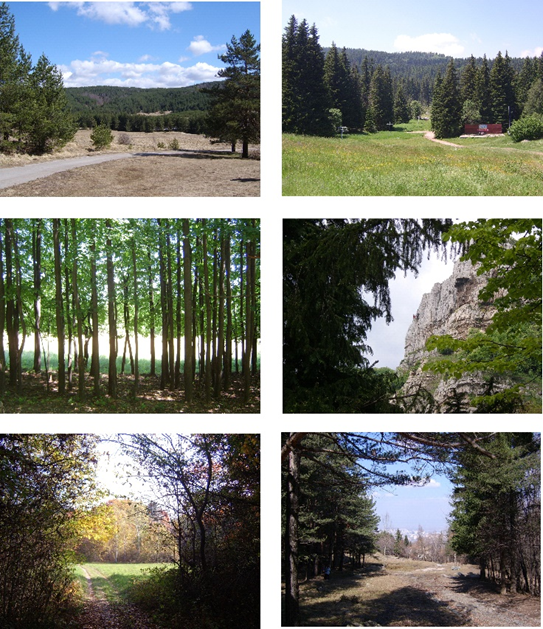
Figure 12. Visual frames
As it is shown in Figure 12 the visual frames can be on both sides of landscape views, but in some cases these frames can be of the three and even of the four sides of the natural picture. It may even represent an openwork screen that transmits the eyes of the observer beyond.
Artistic process during landscape planing requires creating spectacular views until we get the whole picture of a recreational forest landscape. Unlike urban environment where we have to comply strictly with the architectural framework, in forest areas we have to make much less intervention and to take into account the main environmental features. In order to make the design project more realistic and to ensure its subsequent implementation in real space it is advisable to use existing tree groups and massifs, which immediately or after a partial reconstruction could assume the functions of the relevant part of the perspective view.
In this case, some essential principles, combining parts of park perspective methods and spatial composition can make design process much meaningful and the resulting natural landscape more picturesque and attractive. Such principles must be sufficiently simple, fast and effective to provide an aesthetic forest landscape design.
- Chuhovski, P. Constructive perspective. Sofia, 1968.
- Gurkova, M. Protection and Socialisation Principles and Methods of Cultural Heritage in Forest Areas, PhD thesis, University of Forestry, Sofia, Bulgaria, 2016.
- Makarova, M., Practical Perspective. Moscow, 2004.
- Rock, I. Introduction to visual perception. Part 1 and 2, Moscow, Pedagogy, 1980.
- Ratnichin, V., Perspective. Higher Discipline, Kiev, 1972.
- Stoycheva, M. A Spatial Method in the Park Design, PhD thesis, University of Forestry, Sofia, Bulgaria, 2016.
- Vergunov, A., Denisov, S. Burns, Landscape Design. Moscow, 1991.
- Verlade, M., G. Fry, M. Tveit, Health effects of viewing landscapes. Landscape types in environmental psyhology, Urban Forestry & Urban Greening, 6, 2007.
- Walker, P., Modeling the Landscape. Representing Landscape Architecture, 2008.[schema type=»book» name=»VISUAL PERCEPTIONS AND FOREST LANDSCAPE DESIGN PRINCIPLES ALONG WALKING TRAILS» description=»The panoramic views and attractive landscape fragments and landscape paintings are often the main focus in the construction of trails for hiking, cycling, mountain biking and horse riding. Most of them use the existing pedestrian routes that do not always provide the tourist demand landscape attractiveness. It is a serious study and application of compositional principles for the formation of spaces along the tourist trails to increase the mental-emotional impact of forest landscapes on tourists. The article discusses the application of the principles of landscape architecture for environmental friendliness, logical paths, optimal visual quality and landscape impacts on the tourists. Particular attention was given to the role of eco-trails as a prerequisite for contemplation of unique landscapes, enhance cognitive nature of outdoor recreation and suggesting respect for nature by tourists. » author=»Emil Galev, Diana Koprinska, Maria Stoycheva» publisher=»БАСАРАНОВИЧ ЕКАТЕРИНА» pubdate=»2017-01-13″ edition=»ЕВРАЗИЙСКИЙ СОЮЗ УЧЕНЫХ_30.12.16_33(2)» ebook=»yes» ]

